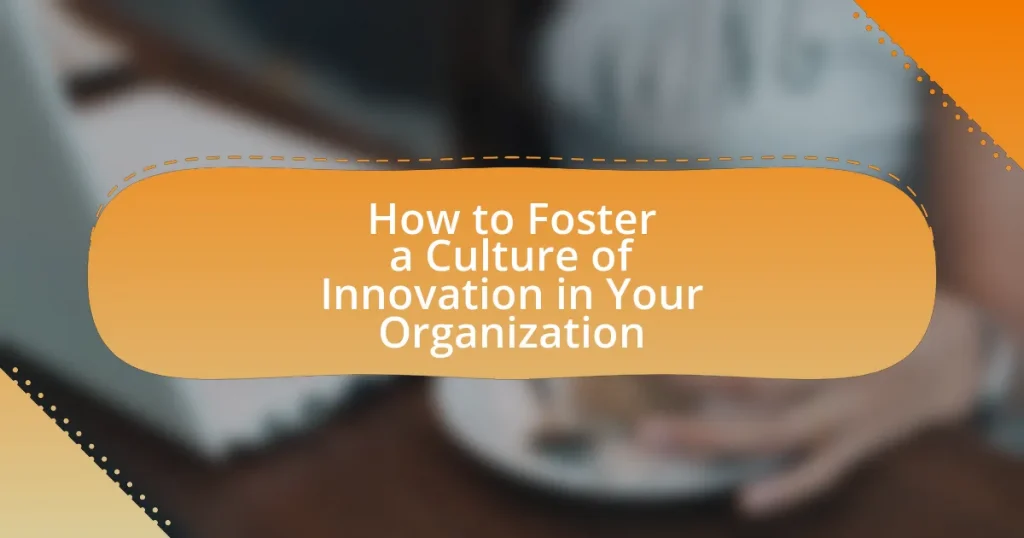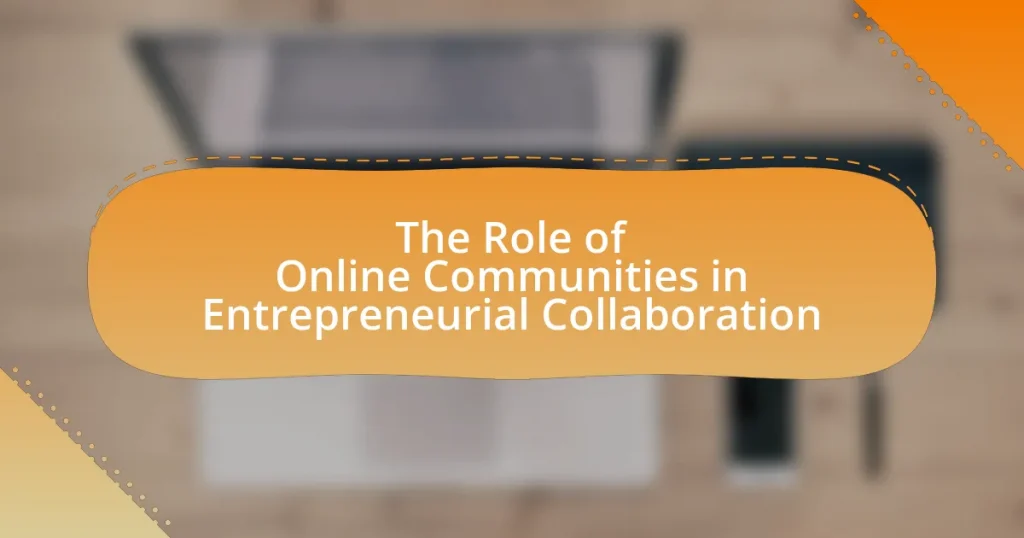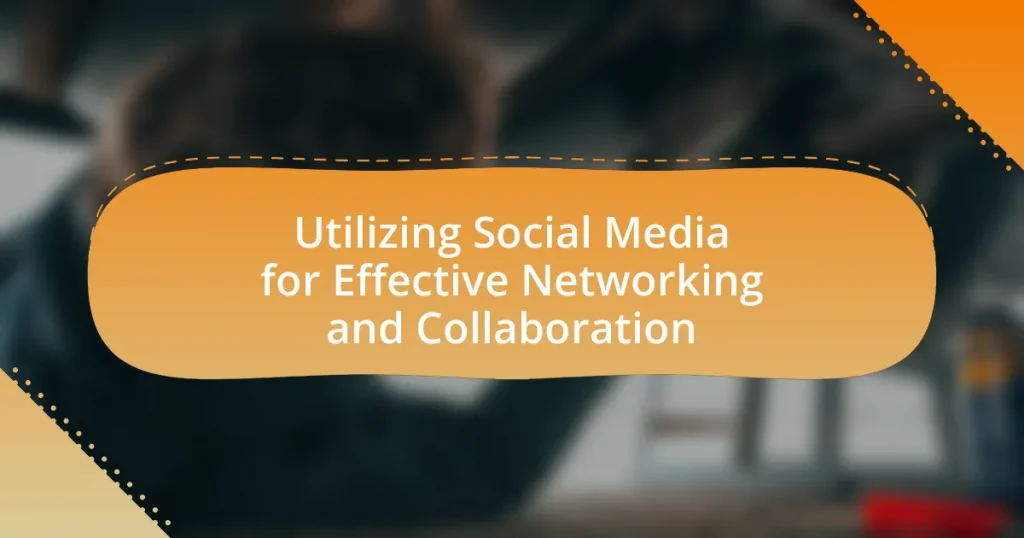Fostering a culture of innovation in an organization involves creating an environment that promotes creativity, collaboration, and risk-taking among employees. This article explores the significance of innovation for organizational growth, employee engagement, and competitive advantage, highlighting key characteristics of innovative organizations and the influence of leadership styles. It also addresses common challenges, misconceptions, and practical strategies for implementing and sustaining an innovative culture, including the role of recognition and rewards, collaboration, and technology. By understanding these elements, organizations can effectively enhance their innovative capabilities and drive long-term success.
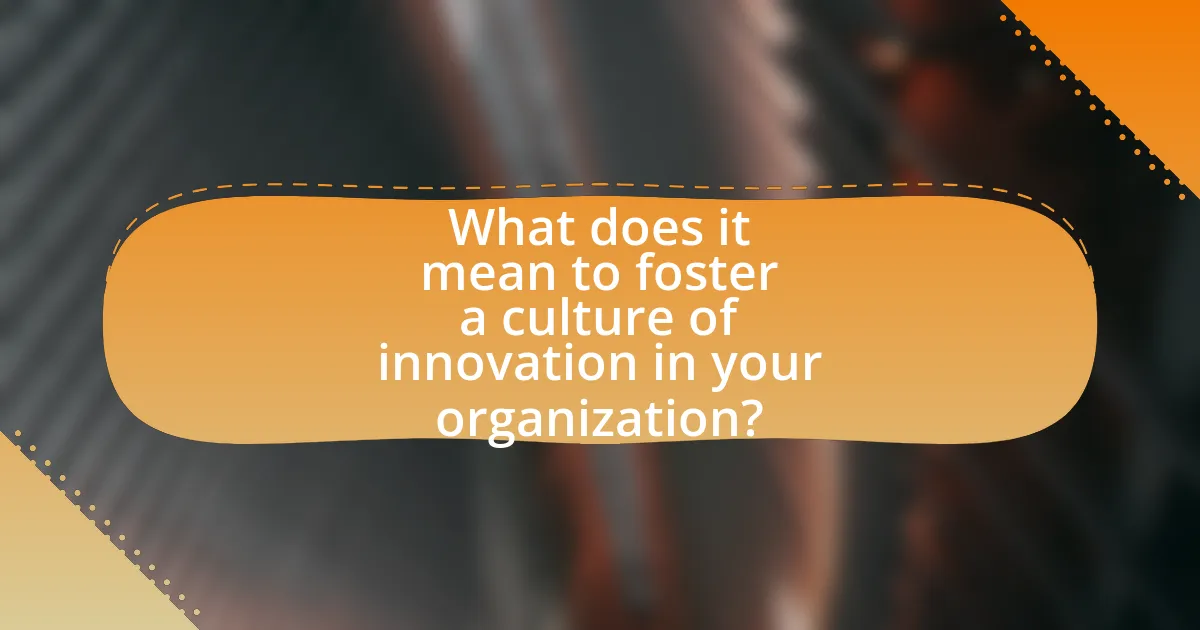
What does it mean to foster a culture of innovation in your organization?
Fostering a culture of innovation in an organization means creating an environment that encourages creativity, experimentation, and the sharing of ideas among employees. This involves implementing practices that support risk-taking, collaboration, and open communication, allowing individuals to contribute their unique perspectives without fear of failure. Research shows that organizations with a strong culture of innovation, such as Google, often experience higher employee engagement and improved performance, as they empower teams to explore new solutions and adapt to changing market demands.
Why is fostering a culture of innovation important for organizations?
Fostering a culture of innovation is important for organizations because it drives competitive advantage and enhances adaptability in a rapidly changing market. Organizations that prioritize innovation are more likely to develop new products, improve processes, and respond effectively to customer needs, which can lead to increased market share and profitability. For instance, a study by McKinsey found that companies with strong innovation cultures are 3.5 times more likely to outperform their peers in terms of revenue growth. This demonstrates that a commitment to innovation not only fuels creativity but also translates into tangible business success.
How does a culture of innovation impact employee engagement?
A culture of innovation significantly enhances employee engagement by fostering an environment where employees feel valued and empowered to contribute ideas. When organizations prioritize innovation, they encourage collaboration and creativity, leading to increased job satisfaction and motivation among employees. Research from Gallup indicates that companies with high employee engagement levels experience 21% greater profitability, highlighting the direct correlation between an innovative culture and engaged employees. Furthermore, organizations that support innovation often see lower turnover rates, as employees are more likely to remain with companies that invest in their growth and ideas.
What role does innovation play in organizational growth?
Innovation is a critical driver of organizational growth, as it enables companies to develop new products, improve processes, and enhance customer experiences. By fostering a culture of innovation, organizations can adapt to market changes, meet evolving consumer demands, and differentiate themselves from competitors. Research indicates that companies prioritizing innovation experience higher revenue growth; for instance, a study by McKinsey found that organizations with strong innovation capabilities achieve 2.5 times higher revenue growth than their peers. This correlation underscores the importance of integrating innovation into the organizational strategy to sustain long-term growth and competitiveness.
What are the key characteristics of an innovative organization?
An innovative organization is characterized by a strong emphasis on creativity, adaptability, and a collaborative culture. These organizations encourage risk-taking and experimentation, allowing employees to explore new ideas without the fear of failure. For instance, companies like Google and 3M have implemented policies that promote innovation, such as allowing employees to dedicate a portion of their work time to personal projects, resulting in successful products like Gmail and Post-it Notes. Additionally, innovative organizations prioritize continuous learning and development, fostering an environment where knowledge sharing and diverse perspectives are valued, which enhances problem-solving capabilities and drives innovation forward.
How do leadership styles influence innovation culture?
Leadership styles significantly influence innovation culture by shaping the environment in which creativity and risk-taking are encouraged or stifled. Transformational leadership, for instance, fosters an open and collaborative atmosphere that motivates employees to share ideas and experiment, leading to higher levels of innovation. Research by Bass and Avolio (1994) indicates that transformational leaders inspire followers to exceed their own self-interests for the sake of the organization, which enhances innovative behaviors. Conversely, autocratic leadership tends to suppress creativity, as it discourages input from team members and creates a fear of failure, ultimately hindering innovation. A study by Amabile (1996) found that environments characterized by supportive leadership are more conducive to creative problem-solving and innovation. Thus, the leadership style adopted within an organization directly impacts its innovation culture by either promoting or inhibiting creative processes.
What practices encourage creativity among employees?
Practices that encourage creativity among employees include fostering an open communication environment, providing opportunities for collaboration, and allowing flexible work arrangements. Open communication enables employees to share ideas freely, which has been shown to enhance creative thinking. For instance, a study by the Harvard Business Review found that teams with high levels of communication are 25% more productive and innovative. Collaboration across diverse teams brings together different perspectives, leading to more innovative solutions. Additionally, flexible work arrangements, such as remote work or flexible hours, have been linked to increased job satisfaction and creativity, as reported by a study from Stanford University, which found that remote workers were 13% more productive than their in-office counterparts.
What challenges do organizations face in fostering innovation?
Organizations face several challenges in fostering innovation, including resistance to change, lack of resources, and insufficient leadership support. Resistance to change often stems from established routines and fear of the unknown, which can hinder the adoption of new ideas. A lack of resources, both financial and human, limits the ability to experiment and implement innovative solutions. Additionally, insufficient leadership support can create an environment where innovation is not prioritized, leading to a culture that stifles creativity. According to a study by McKinsey, 70% of change initiatives fail due to employee resistance, highlighting the critical need for organizations to address these challenges effectively.
How can resistance to change hinder innovation efforts?
Resistance to change can significantly hinder innovation efforts by creating an environment where new ideas are stifled and existing processes are maintained despite their inefficiencies. When employees resist change, they often cling to outdated practices, which can lead to a lack of experimentation and exploration of novel solutions. For instance, a study by the Harvard Business Review found that organizations with high levels of resistance to change are 70% less likely to implement innovative practices successfully. This resistance not only slows down the adoption of new technologies but also demotivates employees who are eager to innovate, ultimately resulting in missed opportunities for growth and competitive advantage.
What are common misconceptions about innovation in the workplace?
Common misconceptions about innovation in the workplace include the belief that innovation is solely the responsibility of a designated team or that it requires significant financial investment. Many organizations mistakenly think that only specific departments, like R&D, are tasked with innovation, while in reality, fostering a culture of innovation involves every employee contributing ideas and solutions. Additionally, the notion that innovation demands large budgets is misleading; many successful innovations arise from low-cost, incremental changes rather than expensive projects. Research by the Harvard Business Review indicates that companies with a culture of innovation encourage participation from all levels, leading to more diverse ideas and solutions.
How can organizations effectively implement a culture of innovation?
Organizations can effectively implement a culture of innovation by fostering an environment that encourages creativity, collaboration, and risk-taking. This can be achieved through leadership commitment to innovation, providing resources for experimentation, and establishing clear channels for idea sharing. For instance, companies like Google have implemented policies that allow employees to dedicate a portion of their work time to personal projects, leading to successful innovations such as Gmail and Google Maps. Research shows that organizations with a strong culture of innovation experience 30% higher revenue growth compared to their peers, highlighting the tangible benefits of such an approach.
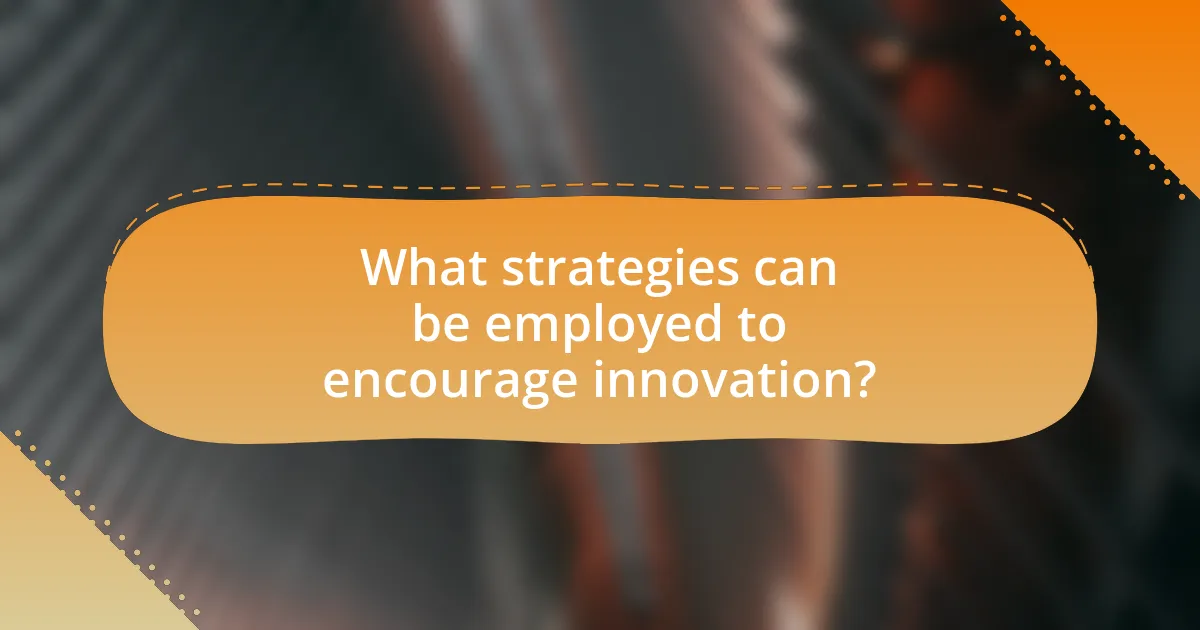
What strategies can be employed to encourage innovation?
To encourage innovation, organizations can implement strategies such as fostering a collaborative environment, providing resources for experimentation, and recognizing and rewarding creative efforts. A collaborative environment promotes diverse ideas and perspectives, which can lead to innovative solutions; for instance, companies like Google utilize open office spaces and team brainstorming sessions to enhance collaboration. Providing resources for experimentation, such as time and funding for projects, allows employees to explore new concepts without the fear of failure; 3M famously allocates 15% of employees’ time for personal projects, resulting in products like Post-it Notes. Recognizing and rewarding creative efforts motivates employees to think outside the box; research from the Harvard Business Review indicates that organizations with recognition programs see a 14% increase in employee engagement, which correlates with higher innovation rates.
How can organizations create an environment that supports innovation?
Organizations can create an environment that supports innovation by fostering a culture of collaboration and open communication. This involves encouraging team members to share ideas without fear of criticism, which can lead to creative solutions and improvements. Research shows that companies with high levels of employee engagement and collaboration, such as Google, experience greater innovation outcomes, as they empower employees to contribute to projects and initiatives actively. Additionally, providing resources such as time for experimentation and access to training can further enhance innovative capabilities, as seen in organizations like 3M, which allocates 15% of employees’ time for personal projects, resulting in successful products like Post-it Notes.
What role does collaboration play in fostering innovation?
Collaboration is essential in fostering innovation as it combines diverse perspectives and expertise, leading to creative problem-solving and new ideas. When individuals from different backgrounds and skill sets work together, they can challenge each other’s assumptions and generate innovative solutions that may not emerge in isolation. Research indicates that organizations that promote collaborative environments experience a 15% increase in productivity and a 20% boost in innovation outcomes, as highlighted in a study by the Institute for Corporate Productivity. This demonstrates that collaboration not only enhances creativity but also drives tangible results in innovation.
How can organizations leverage diversity to enhance innovation?
Organizations can leverage diversity to enhance innovation by fostering a variety of perspectives and ideas that drive creative problem-solving. Diverse teams bring together individuals with different backgrounds, experiences, and viewpoints, which can lead to more innovative solutions. Research from McKinsey & Company indicates that companies in the top quartile for gender and ethnic diversity are 35% more likely to have financial returns above their respective national industry medians. This correlation suggests that diversity not only enhances creativity but also contributes to better business performance. By actively promoting an inclusive environment, organizations can harness the full potential of their diverse workforce, leading to increased innovation and competitive advantage.
What tools and resources can support innovation initiatives?
Collaboration platforms, project management tools, and innovation management software are essential resources that can support innovation initiatives. Collaboration platforms like Slack and Microsoft Teams facilitate communication and idea sharing among team members, enhancing creativity and collaboration. Project management tools such as Trello and Asana help organize tasks and track progress, ensuring that innovative projects stay on schedule. Innovation management software, like IdeaScale and Spigit, allows organizations to collect, evaluate, and implement ideas from employees, fostering a structured approach to innovation. These tools collectively create an environment conducive to innovation by streamlining processes and encouraging participation.
How can technology facilitate innovative processes?
Technology facilitates innovative processes by providing tools that enhance collaboration, streamline workflows, and enable data-driven decision-making. For instance, cloud-based platforms allow teams to work together in real-time, regardless of location, which accelerates the development of new ideas. Additionally, data analytics tools can identify trends and insights that inform innovation strategies, leading to more effective solutions. Research from McKinsey & Company indicates that organizations leveraging advanced technologies are 2.5 times more likely to be top innovators in their industries, demonstrating the significant impact of technology on fostering innovation.
What training programs are effective in promoting innovative thinking?
Training programs that effectively promote innovative thinking include design thinking workshops, creativity training sessions, and collaborative problem-solving initiatives. Design thinking workshops encourage participants to empathize with users, define problems, ideate solutions, prototype, and test, fostering a mindset geared towards innovation. Creativity training sessions often utilize techniques such as brainstorming, lateral thinking, and mind mapping to enhance creative skills. Collaborative problem-solving initiatives leverage diverse team dynamics to generate unique solutions, as evidenced by studies showing that diverse teams produce more innovative outcomes. These programs are supported by research indicating that structured approaches to creativity and collaboration significantly enhance innovative capabilities within organizations.
How can organizations measure the success of their innovation culture?
Organizations can measure the success of their innovation culture through key performance indicators (KPIs) such as the number of new ideas generated, the rate of idea implementation, and employee engagement scores related to innovation. For instance, a study by McKinsey found that companies with a strong innovation culture report 2.5 times higher revenue growth compared to their peers. Additionally, organizations can assess the impact of innovation on financial performance by tracking metrics like return on investment (ROI) for innovation projects and market share growth attributed to new products or services. These metrics provide concrete evidence of how effectively an organization fosters and benefits from its innovation culture.
What metrics are useful for assessing innovation outcomes?
Useful metrics for assessing innovation outcomes include return on investment (ROI), time to market, and customer satisfaction scores. ROI quantifies the financial return generated from innovation initiatives, providing a clear measure of their economic impact. Time to market assesses the speed at which new products or services are developed and launched, indicating the efficiency of the innovation process. Customer satisfaction scores reflect how well innovations meet market needs and expectations, serving as a direct measure of their success in the marketplace. These metrics collectively offer a comprehensive view of innovation effectiveness and its contribution to organizational goals.
How can feedback loops improve innovation practices?
Feedback loops can significantly enhance innovation practices by facilitating continuous learning and adaptation within organizations. These loops allow teams to gather insights from various stakeholders, including customers and employees, which can inform and refine the innovation process. For instance, a study by the Harvard Business Review found that companies that actively solicit and incorporate feedback are 2.5 times more likely to be innovative than those that do not. This iterative process not only helps in identifying potential flaws early but also encourages a culture of collaboration and openness, leading to more effective and relevant innovations.
What are some best practices for sustaining a culture of innovation?
To sustain a culture of innovation, organizations should prioritize open communication, encourage risk-taking, and provide continuous learning opportunities. Open communication fosters collaboration and idea sharing, which are essential for innovation. Encouraging risk-taking allows employees to experiment without fear of failure, leading to creative solutions. Providing continuous learning opportunities, such as workshops and training, equips employees with the skills needed to innovate effectively. Research by the Harvard Business Review indicates that companies with a strong culture of innovation see 30% higher revenue growth compared to their peers, demonstrating the effectiveness of these practices.

How can leaders champion innovation within their organizations?
Leaders can champion innovation within their organizations by fostering an environment that encourages creativity and risk-taking. This involves implementing policies that support experimentation, such as allocating resources for research and development and allowing employees to pursue innovative projects without fear of failure. For instance, companies like Google have successfully adopted the “20% time” policy, where employees can dedicate a portion of their workweek to projects they are passionate about, leading to significant innovations like Gmail and Google Maps. By actively promoting open communication and collaboration, leaders can also facilitate the sharing of ideas across teams, further enhancing the innovative capacity of the organization.
What actions can leaders take to inspire innovative thinking?
Leaders can inspire innovative thinking by fostering an open environment that encourages experimentation and risk-taking. This can be achieved by implementing regular brainstorming sessions where team members feel safe to share unconventional ideas without fear of criticism. Research shows that organizations with a culture of psychological safety, such as Google, report higher levels of creativity and innovation among employees. Additionally, leaders can provide resources and time for employees to pursue passion projects, which has been linked to increased engagement and innovative outcomes. By recognizing and rewarding innovative efforts, leaders reinforce the value of creativity within the organization, further motivating teams to think outside the box.
How can leaders model innovative behavior for their teams?
Leaders can model innovative behavior for their teams by actively demonstrating creativity, encouraging risk-taking, and fostering an open environment for idea sharing. By engaging in brainstorming sessions and showcasing their own innovative projects, leaders set a precedent for team members to follow. Research indicates that organizations with leaders who prioritize innovation see a 30% increase in employee engagement and creativity, as highlighted in the study “The Role of Leadership in Fostering Innovation” by the Harvard Business Review. This evidence underscores the importance of leaders not only advocating for innovation but also embodying it in their daily actions and decision-making processes.
What communication strategies enhance innovation culture?
Effective communication strategies that enhance innovation culture include fostering open dialogue, encouraging feedback, and promoting collaboration. Open dialogue allows team members to share ideas freely, which is essential for generating innovative solutions. Encouraging feedback creates a safe environment where individuals feel valued and motivated to contribute, leading to a more dynamic exchange of ideas. Promoting collaboration across departments breaks down silos, facilitating diverse perspectives that can spark creativity. Research indicates that organizations with strong communication practices are 3.5 times more likely to be innovative, highlighting the critical role of these strategies in cultivating an innovation-driven culture.
What role does recognition and reward play in fostering innovation?
Recognition and reward play a crucial role in fostering innovation by motivating individuals to contribute creatively and take risks. When employees receive acknowledgment for their innovative ideas and efforts, it reinforces their behavior and encourages a culture of experimentation. Research by the Harvard Business Review indicates that organizations with robust recognition programs see a 31% lower voluntary turnover rate, which suggests that employees are more likely to stay and innovate when they feel valued. Additionally, a study from Gallup found that employees who feel recognized are 2.7 times more likely to be engaged in their work, leading to higher levels of creativity and innovation. Thus, effective recognition and reward systems are essential for cultivating an environment where innovation can thrive.
How can organizations effectively recognize innovative contributions?
Organizations can effectively recognize innovative contributions by implementing structured recognition programs that highlight individual and team achievements. These programs can include awards, public acknowledgments during meetings, and integration of innovation metrics into performance evaluations. Research indicates that organizations with formal recognition systems see a 14% increase in employee engagement, which correlates with higher innovation output. For instance, companies like Google and 3M have successfully utilized recognition strategies to foster creativity and innovation, demonstrating that acknowledgment of innovative efforts leads to a more motivated workforce.
What types of rewards motivate employees to innovate?
Monetary rewards, recognition, and opportunities for professional growth are the primary types of rewards that motivate employees to innovate. Monetary rewards, such as bonuses or profit-sharing, provide tangible incentives that directly link financial gain to innovative efforts. Recognition, including awards or public acknowledgment, fosters a sense of accomplishment and encourages employees to pursue creative solutions. Opportunities for professional growth, such as training programs or career advancement, empower employees by enhancing their skills and reinforcing the value of innovation within the organization. Research indicates that organizations that implement these reward systems experience higher levels of employee engagement and creativity, leading to a more robust culture of innovation.
What practical steps can organizations take to foster a culture of innovation?
Organizations can foster a culture of innovation by implementing structured brainstorming sessions that encourage diverse input and collaboration. These sessions can lead to the generation of new ideas, as evidenced by a study from the Harvard Business Review, which found that companies that prioritize collaborative brainstorming see a 20% increase in innovative outputs. Additionally, organizations should establish a safe environment for risk-taking, allowing employees to experiment without fear of failure; research from the University of Pennsylvania indicates that companies with a supportive culture for experimentation report higher employee engagement and creativity. Furthermore, providing continuous learning opportunities, such as workshops and training programs, can enhance employees’ skills and inspire innovative thinking, as shown by a report from McKinsey, which states that organizations investing in employee development are 2.5 times more likely to be innovation leaders in their industry.
